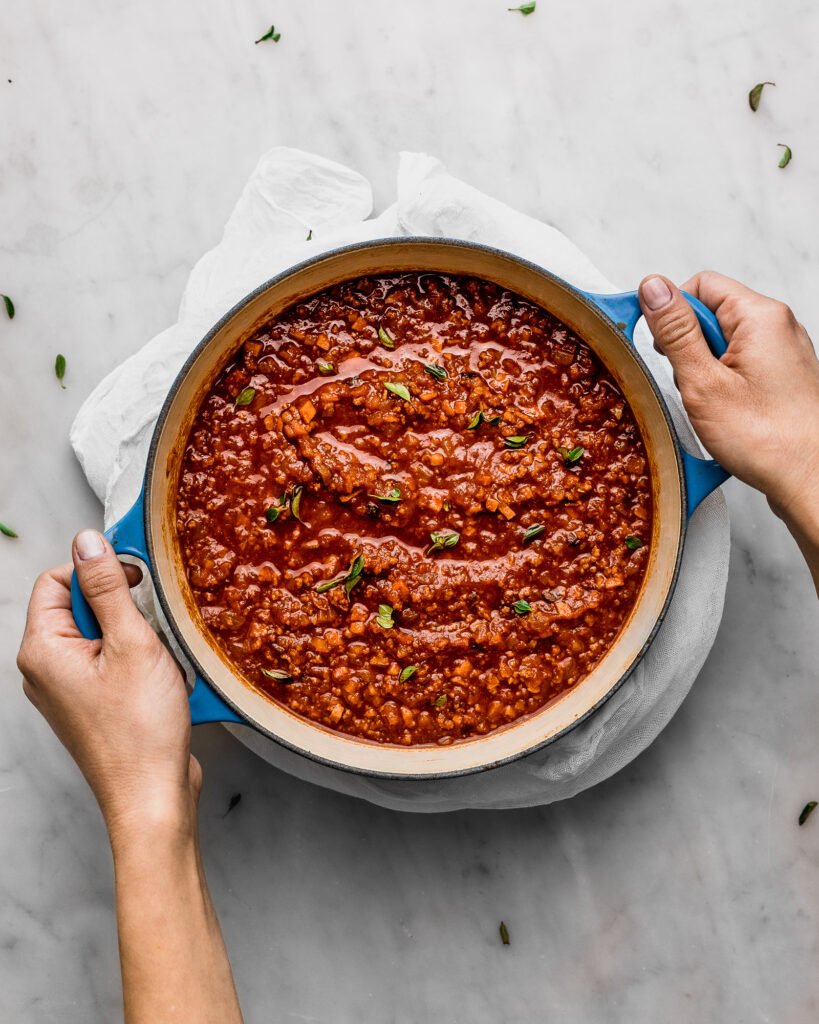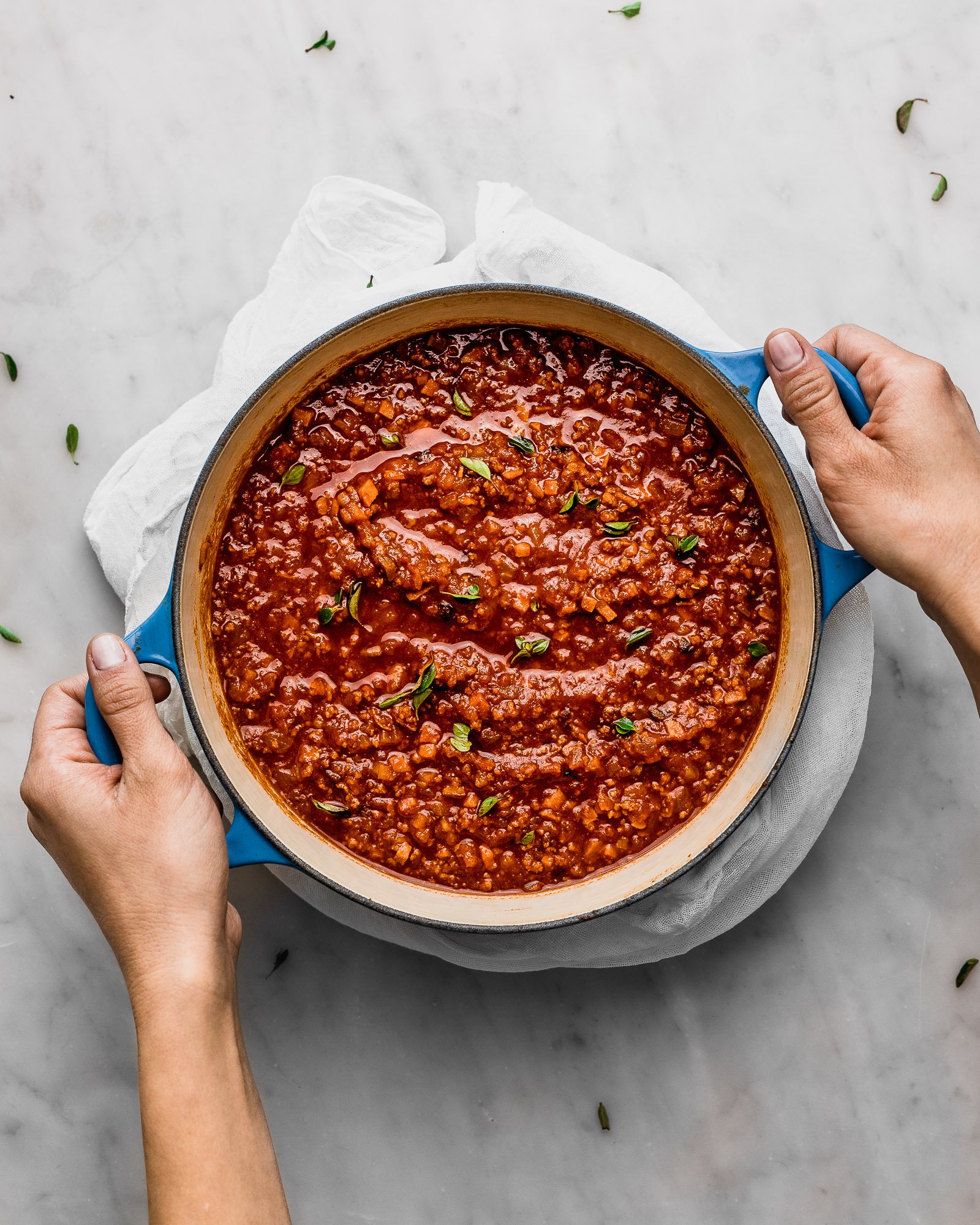It doesn’t matter if you call it meat sauce or ragu Bolognese; the combination of meat, tomatoes, and pasta is deeply satisfying. A true Italian Bolognese sauce requires more than just ground beef and a jar of marinara.
What is Bolognese?
Bolognese is a popular recipe that evolved. The dish developed due to the return of American soldiers from Italy following World War II and the arrival of waves upon arrival of Italian immigrants to the United States.
Bolognese is a sauce made from ground beef and tomatoes on this side of the Atlantic. Similar versions are also very popular in Germany and other European countries. This dish is not available in Italy.
Today’s authentic Italian Bolognese uses minced flank steak instead of ground chuck. It also has milk, and beef broth and simmers for hours to achieve a complex flavour. It is not possible to mix a jar with sauce in ground beef.

Can you freeze bolognese sauce?
Yes, you can freeze it so you can enjoy it later. The bolognese sauce freezes well and can last for up to three months. Either freeze the sauce and pasta together or the sauce by itself.
People often make large batches of Bolognese to freeze to save time and keep dinner light during busy weeks.
How do you freeze Bolognese sauce?
Let’s look at how to freeze it.
Step 1 – Preparation
Allow the beef sauce to cool down before freezing. If the sauce is at room temperature, it’s best to store it immediately. However, hot or warm sauces should not be stored directly in the freezer because they can increase the temperature.
For the first 2 hours, refrigerated food should remain between 120 and 70 degrees Fahrenheit and then 70 to 45 degrees Fahrenheit for the following four hours. Let the sauce cool to room temperature for at least 2 hours before storing it in the refrigerator.
You can also put the sauce into a container and place it in a large bowl of cold water. The cooling process will be accelerated if you stir the sauce frequently. Once your sauces are cool, you can put them in the fridge or freezer.
Step 2 – Find the right container.
Next, identify the type of container. Sauces and other foods should not be stored in glass containers. The food inside could expand during freezing, which can cause the container to crack. Instead, you should use plastic containers.
Step 3: Proper Storage
Instead of storing large quantities of sauce, consider how you will use them once they are thawed. Divide them before freezing. You can freeze a small amount of sauce in an ice tray or small freezer bags if you only require a little.
This saves space and helps you reheat individual portions more quickly. You can avoid freezer burn by removing excess air from the container or choosing a container allowing small air movement.

How do you defrost Bolognese Sauce?
There are many ways to freeze Bolognese sauce. Depending on how quickly you need it, there are many options.
-
Refrigerator Method
The fridge is my first and most preferred method.
To thaw, place the frozen sauce in the refrigerator. It is best to keep the sauce cool and not at room temperature. This prevents harmful bacteria from growing.
To maintain a consistent consistency, you can freeze your frozen sauce overnight.
-
Warm Water Method
If impatient, place the bag or container in a bowl with warm water. Think of Goldilocks. Not too hot, but not too cold. Just right. It can sit for anywhere from thirty to forty-five to five minutes. It will take longer, depending on the size of your portion. If you had listened to me and divided the sauce into smaller pieces, we wouldn’t have this problem.
-
Microwave Method
Microwave the sauce for quick and easy thawing. After you have removed the frozen sauce from the bag or container, place the Bolognese into a microwave-safe bowl. Cover it with a paper towel.
Trust me; you’re going to need to cover your sauce. Sauce splatters when it heats, which is why you may have to clean out my microwave many times. This will save you a lot of time and from a mess.
Microwave the bowl on high for 2 to 3 minutes. After that, check every minute increment and stir. This will reduce the amount of splattered sauce and help keep it warm. The microwave can also be used with the “defrost” setting.
-
Stovetop Method
Another way to heat frozen sauce is to use a saucepan on the stove. Once the sauce has thawed, heat the sauce in a saucepan on the stovetop. Stir occasionally for around fifteen minutes.
Can You Freeze Spaghetti Bolognese?
You can freeze spaghetti Bolognese sauce for later consumption. It’s easy to freeze spaghetti Bolognese. It will keep for at least 3 months. Either freeze the sauce and pasta together or the sauce alone.
People often make large batches of spaghetti Bolognese and freeze them to have quick tasty meals during the week.
Can you Freeze Dolmio Bolognese Sauce?
You can freeze Dolmio Bolognese sauce if you keep it in an airtight container. It can be stored in an airtight container for 3 months before it begins to lose its texture or taste. Dolmio Bolognese sauce will keep fresh for up to 3 months in the freezer. The sauce’s consistency and taste will begin to decline after this time. The sauce’s flavor compounds begin to evaporate with time.
Step-by-step Guide To Freezing Dolmio Bolognese Sauce
You need to follow these steps to freeze Dolmio Bolognese sauce.
- You should not freeze your sauce in its original jar. The jar doesn’t allow the liquid to cool or expand while it freezes. This will cause the jar inside to shatter.
- You can also grab any freezer-safe, airtight container with enough space at the top for the sauce to expand.
- To prevent leakage, seal the container well.
- Now, place the container in the freezer.
How to Reheat Bolognese Sauce?
Bolognese can either be heated on the stovetop or in a microwave.
To avoid scorching, heat the pan on medium heat. Stir frequently. It should take approximately five minutes, but it depends on how large the portion you are reheating.
Before serving, ensure that the bolognese sauce reaches a minimum temperature of 75°C.
To heat the bolognese sauce in a microwave, heat it on high for 1-2 minutes, depending on the portion size. To ensure even cooking, stir frequently. Before serving, the sauce must be hot.
You can add water to the sauce if it starts drying out.

Frequently Asked Questions
How long does Bolognese sauce last after defrosting?
The bolognese sauce can be stored in the refrigerator for up to three days if it is not frozen on the day you made it.
Is it possible to freeze Bolognese sauce with milk?
It can be frozen without any worries, just like regular Bolognese sauce.
Is it possible to freeze Bolognese Sauce from a Jar?
Bolognese sauce is safe to freeze, whether homemade or jar.
Can You Freeze Dolmio Bolognese Sauce?
Yes, dolmio Bolognese sauce is possible to freeze. Dolmio Bolognese Sauce freezes well. There is no discernible loss of flavor or texture. It can also be stored in the freezer.


We are baking experts and connoisseur of food with decades of cooking experience to cook and bake a variety of scrumptious food item to awaken the taste buds of people who eat our baked delights.
With our gumption, alacrity along with astute acumen to pick the authentic and best quality ingredients from across the world to make the scrumptious recipes which soothes the taste buds of eater has made him the name on which people can count on when it comes to cooking advice, world class meals and cuisines native to the different cities of world.
Our chefs unique ability improvise and make baked dishes with different raw produce and ingredients in less time which are delicious and relished by the guests has made kooky bakes leader in the arena of baking and serving mouth watering food.


